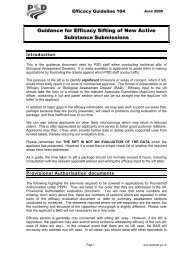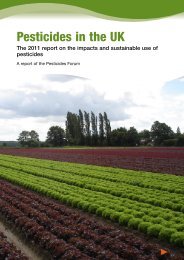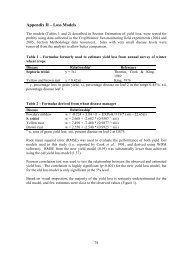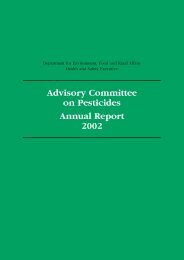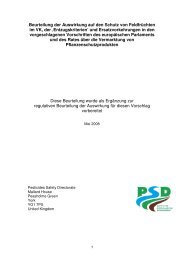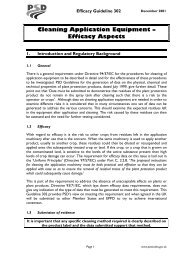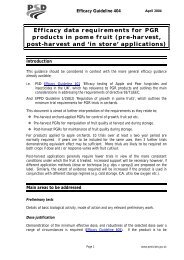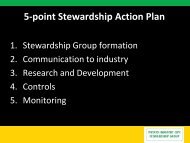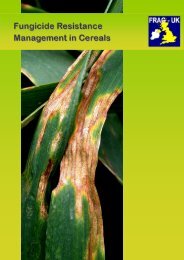Advisory Committee on Pesticides Annual Report 2001
ACP Annual Report 2001 - Pesticides Safety Directorate
ACP Annual Report 2001 - Pesticides Safety Directorate
Create successful ePaper yourself
Turn your PDF publications into a flip-book with our unique Google optimized e-Paper software.
<str<strong>on</strong>g>Advisory</str<strong>on</strong>g> <str<strong>on</strong>g>Committee</str<strong>on</strong>g> <strong>on</strong> <strong>Pesticides</strong> <strong>Annual</strong> <strong>Report</strong> <strong>2001</strong><br />
Overall the ACP c<strong>on</strong>cluded that this study showed no marked difference in<br />
sensitivity to AChE inhibiti<strong>on</strong> between brain AChE and AChE in peripheral<br />
tissues. Red blood cell (RBC) AChE was significantly more sensitive. Therefore<br />
reference values based <strong>on</strong> no observed adverse effect levels (NOAELs) for<br />
inhibiti<strong>on</strong> of brain AChE would be expected to cover AChE in the peripheral<br />
nervous system, and reference values based <strong>on</strong> inhibiti<strong>on</strong> of red blood cell<br />
AChE in dogs would be c<strong>on</strong>servative. The <str<strong>on</strong>g>Committee</str<strong>on</strong>g> thus decided that<br />
reference values for chlorpyrifos should be based <strong>on</strong> NOAELs for inhibiti<strong>on</strong> of<br />
brain AChE in dogs, since the results of the dog study examining peripheral<br />
tissues suggest that such reference values would also protect the peripheral<br />
nervous system. It was c<strong>on</strong>cluded that the ADI and AOEL for chlorpyrifos<br />
should be maintained at 0.01 mg/kg bw/day.<br />
On the basis of this reference value the <str<strong>on</strong>g>Committee</str<strong>on</strong>g> recommended that<br />
approvals for chlorpyrifos could c<strong>on</strong>tinue as previously recommended.<br />
The <str<strong>on</strong>g>Committee</str<strong>on</strong>g> also asked that some further investigati<strong>on</strong> of drench<br />
treatment with chlorpyrifos be carried out.<br />
42<br />
Chlorpyrifos – ornamental bulb dipping<br />
When the ACP had c<strong>on</strong>sidered chlorpyrifos in July 2000, it had recommended,<br />
am<strong>on</strong>g other things, that off-label approval for use as a bulb dip should be<br />
revoked unless a suitable protocol for an operator exposure study was<br />
provided within eight weeks. However, subsequent to the ACP c<strong>on</strong>siderati<strong>on</strong>,<br />
the off-label approval for this use expired and no further acti<strong>on</strong> was taken.<br />
The ACP heard that this approval had been allowed to lapse through oversight<br />
<strong>on</strong> the part of the off-label applicants and was an important use which grower<br />
groups were prepared to c<strong>on</strong>tinue to support. The ACP noted that exposure<br />
had been estimated using the Health and Safety Executive’s (HSE’s) waterbased<br />
timber pre-treatment model based <strong>on</strong> 95 th percentile values and that<br />
estimated exposure was 130 percent of the AOEL. The <str<strong>on</strong>g>Committee</str<strong>on</strong>g> felt that<br />
when based <strong>on</strong> the usual 75 th percentile values, estimated exposures were<br />
likely to fall within the AOEL.<br />
The ACP recommended that the off-label approval for the use of chlorpyrifos<br />
for bulb dipping should be reinstated and that the secretariat should c<strong>on</strong>sider,<br />
with the off-label applicants, further refinement of the risk assessment<br />
including handling of treated bulbs and disposal of dipping soluti<strong>on</strong>.<br />
Note: The recommendati<strong>on</strong> to reinstate the off-label approval was not a<br />
unanimous c<strong>on</strong>clusi<strong>on</strong> of the <str<strong>on</strong>g>Committee</str<strong>on</strong>g>.




